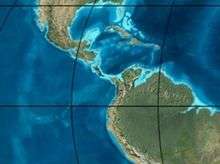Castillo Formation
| Castillo Formation Stratigraphic range: Oligocene-Miocene | |
|---|---|
| Type | Geological formation |
| Underlies | Capadare Formation |
| Overlies | Matatere Fm., El Paují Fm. and Jarillal Fm. |
| Lithology | |
| Primary | Shallow marine siliciclastics |
| Location | |
| Coordinates | 10°33′50″N 69°43′42″W / 10.56389°N 69.72833°WCoordinates: 10°33′50″N 69°43′42″W / 10.56389°N 69.72833°W |
| Region | Lara |
| Country | Venezuela |
| Extent | from La Mesa to Siquisique |
 Paleogeography of Northern South America, 20 Ma by Ron Blakey | |

Type locality of the Castillo Formation in Venezuela
The Castillo Formation is a Oligocene to Miocene geologic formation in Venezuela. The formation unconformably overlies the Matatere, El Paují and Jarillal Formations.[1] The Castillo Formation is overlain by Quaternary alluvium and in places by the Capadare Formation.[2] In the formation, fossils of the giant sloth Baraguatherium takumara, the turtle Chelus colombiana and the pelican-like Pelagornis sp. have been found. The pelican-like fossil is the oldest of South America.[3][4]
See also
References
- ↑ Urbani & Mendi, 2010, p.17
- ↑ Urbani & Mendi, 2010, p.19
- ↑ (in Spanish) Tres curiosos animales prehistóricos emergen del subsuelo venezolano
- ↑ (in Spanish) Hallan restos de tres animales prehistóricos en Lara
Bibliography
- Urbani, Franco, and David Mendi. 2010. Notas sobre la discordancia del margen sur de la cuenca Oligo-Miocena de Falcón estados Lara, Falcón y Yaracuy, Venezuela. Boletín de la Academia de Ciencias Físicas, Matemáticas y Naturales LXX. 9-25. Accessed 2017-06-05.
This article is issued from
Wikipedia.
The text is licensed under Creative Commons - Attribution - Sharealike.
Additional terms may apply for the media files.